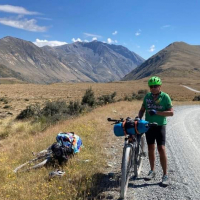Punctures
b12sum
Posts: 3
Sorry if this is old hat but new to biking after hundreds of years.
Things have changed a huge amount .
Since lockdown have gone cycling on roads and occasional light leisure off roading.
what is best advice re punctures please.
BTW my bike is Schrader , wife’s is Presto. I know ,I know.
Is it a puncture repair kit if so which one.
Change tube.
Fill tubes with gunge before we go out, if so which one.
Reinflate after puncture with which pump or compressed containers.
Your help is very much appreciated.
0
Comments
-
all personal choice.
If I'm riding tubed i take one spare tube, 2 tyre levers, pre-glued patches, mini pump and CO2 gas.
If I'm riding tubeless I take tyre worms, mini pump and CO2 gas. I use Doc Blue sealant.0 -
I am definitely tubed. Repair kits have come on a bit nowadays!! Pre-glued for instance. Is there much difference between them all. Mini pump and co2 any recommendations please. Thanks in advancegethinceri said:all personal choice.
If I'm riding tubed i take one spare tube, 2 tyre levers, pre-glued patches, mini pump and CO2 gas.
If I'm riding tubeless I take tyre worms, mini pump and CO2 gas. I use Doc Blue sealant.0 -
i think i have Park Tool patches, pump and gas are Lezyne0
-
Park Tool pre glued patches work well; I've bought other brands and they've lost tackiness whilst in the packet - not much use when you come to use them. Halfords do a CO2 inflator that's pretty good value and will inflate Presta and Schrader..
https://www.halfords.com/cycling/bike-maintenance/bike-pumps/jetvalve-co2-injector-342582.html?istCompanyId=b8708c57-7a02-4cf6-b2c0-dc36b54a327e&istFeedId=367c5610-f937-4c81-8609-f84582324cd6&istItemId=iptiqtrql&istBid=t&_$ja=tsid:94971|cid:868555870|agid:49387670292|tid:aud-297219197929:pla-384255312207|crid:203456299143|nw:g|rnd:11395035067208395211|dvc:c|adp:|mt:|loc:9045378&gclid=EAIaIQobChMIuNfzmKWU7wIVWeh3Ch2vpgFSEAQYASABEgIHOPD_BwE
although you might want to buy extra canisters elsewhere online for a better price/size (i bought larger volume ones from eBay seller). A mini pump might be a cheaper option since i doubt one canister would be enough for a full inflation unless you have thin road tyres
As to tyre sealants there are plenty to choose from, some work better than others but note that some have quite short life times (as little as 3 months in some case in warmer weather). I've used Stans NoTubes as its pretty easy to handle/fill tubes. You could of course just buy replacements Slime tubes which come ready to go; fit them as and when you pick up a puncture ?
0 -
I always carry a spare tube, glueless patches, tyre levers and an good quality mini pump, which gets the tyre hard enough to ride. Also always keep a pair of disposable gloves with them to save your hands getting filthy.0
-
My pump is a Topeak Micro Rocket, works well and is really small.1
-
As above, a spare tube, levers and a pump. If you want more then add some pre-glued patches.
1 -
I still don’t have a lot of faith in pre glued patches. They tend to work better on higher volume lower pressure applications ( MTBs / Hybrids / bigger tyred gravel bikes etc ) than higher pressure lower volume tyres ( typical ‘road bikes’). I keep a tube of vulcanising rubber solution with me and a spare tube, along with levers and CO2 inflators ( 20 gramme threaded type) for the presta valved tubes. There is a knack to getting any patched repair to work well. Make sure the bit of the tube you need to patch is clean and dry, rough the surface of the tube up a bit using the bit of wet and dry paper that comes with most decent patch kits, put the glue on, then leave it for a couple of minutes, before putting the patch on. If you put the patch on too soon, it will tend not to hold. I tend to put a new tube in after a puncture, and hold the patched one as a reserve. If you’re using schrader valves, get a mini pump with a schrader / smart head.0
-
I agree with you on using old school patches and glue. However I tend to put in a new tube when I puncture and then replace it with a repaired one when I get home. This resolves the issue of the repaired spare you take out with you only to find that you made a bit of a bal*s repairing it and you are at the side of the road with 2 punctures.2
-
It's so much quicker to replace a tube at the roadside, and if it's cold or raining (and it will probably be both) then you don't want to take the time. Moreso, if you're out in a group then no-one is going to appreciate you taking the time it takes to do a proper repair roadside.0
-
Its even quicker to repair a tubeless puncture, you don't even need to remove the wheel, or turn the bike upside down etc.... just find the hole, shove a rubber worm in there, reinflate and you're back on your way!
Joking aside, I never got on with pre glued patches, even the park tool ones, never seem to hold properly.
I use the lezyne Co2 pump (the CNC one with a control valve), is very good, and carry 2x 25g cannisters (that's 4x tyre inflations) Also have a lezyne road drive frame pump on the commuter, it's a very good mini pump.0 -
Many thanks for all your replies and comments. Very much appreciated0
-
I carry a spare tube, tyre levers, decent mini pump, and a bog standard puncture repair kit just in case. Also since suffering a couple of sidewall cuts, a Park Tool emergency tyre boot patch thing.
When I get a puncture I carefully check the inside of the tyre then put a new tube in. Punctured tubes if repairable are patched at home in the warm and dry, then back into the spares drawer. Some have several patches but are still perfectly good to use. In fact I suspect all the tubes currently in use have been patched at least once...1




